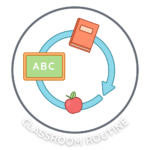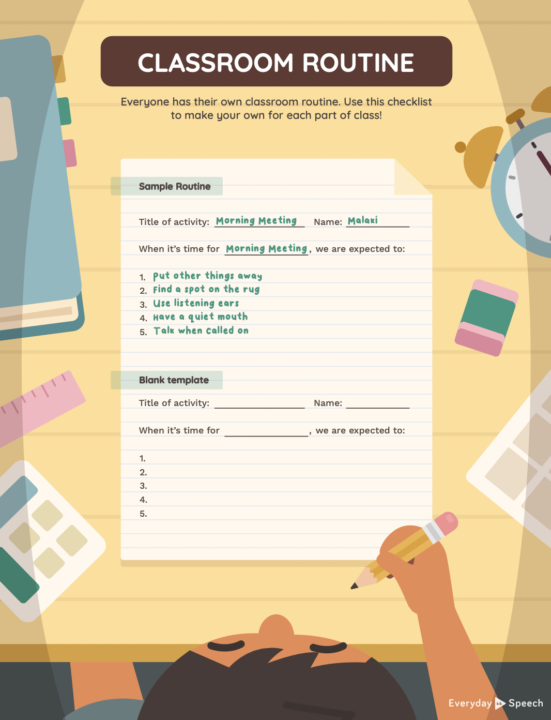
The back-to-school season is an exciting and crucial time for setting the tone for the entire school year. For elementary students, especially those with special needs, learning to follow a consistent classroom routine is essential. Routines provide structure, predictability, and comfort, which can significantly benefit students’ academic and social-emotional development.
As special educators, we play a key role in helping students adjust to these routines in a way that feels empowering and achievable. This blog post will walk you through a simple, no-prep lesson plan that teaches elementary students how to learn and follow a classroom routine.
Why Classroom Routines Matter for Elementary Students
Before diving into the lesson plan, let’s discuss why classroom routines are so important, especially for students in special education. Routines:
- Promote independence: When students know what to expect and what is expected of them, they can navigate the classroom with greater confidence.
- Reduce anxiety: Predictable routines help reduce the uncertainty that can lead to stress or anxiety for students with disabilities, particularly those on the autism spectrum.
- Enhance learning: When routines are in place, students spend less time figuring out what to do and more time focusing on learning.
- Encourage positive behavior: Consistent routines can help students self-regulate and develop positive behavioral patterns over time.
With these benefits in mind, let’s move on to a lesson plan that will help your students grasp and practice following classroom routines.
Lesson Plan: Learning to Follow Classroom Routines
Objective: By the end of this lesson, students will understand the importance of classroom routines and will be able to follow a basic daily routine with increased independence.
Grade Level: K-5
Materials Needed: Whiteboard, markers, goal poster, classroom visual schedule (if available).
Step 1: Introduce the Concept of Routines
Start the lesson by discussing the concept of routines. Ask your students if they have any routines at home, such as brushing their teeth in the morning or getting ready for bed at night. Use these examples to help them connect the idea of routines to their everyday lives.
Activity: On the whiteboard, list some common classroom routines, such as:
- Morning check-in
- Sitting at their desks
- Lining up for lunch
- Cleaning up after activities
- End-of-day dismissal procedures
Explain why routines are important and how they help make the school day run smoothly.
Step 2: Create a Classroom Routine Together
Engage your students by creating a classroom routine together. This can be done by asking them to help you organize the daily schedule. Break the day into key segments, such as:
- Morning meeting
- Academic work time
- Snack break
- Group activities
- Recess
- Lunch
- Free choice time
- End-of-day review
As you work through the schedule, encourage students to ask questions or make suggestions. By involving them in this process, they’ll be more invested in following the routine.
Step 3: Teach Routines through Visuals
For many elementary students, especially those with special needs, visual supports are invaluable for learning and following routines. Consider using a classroom visual schedule with pictures and words to represent different parts of the day. Display it in a prominent place where all students can see it.
Activity: Walk your students through the visual schedule step-by-step. Practice transitioning from one activity to another while referring to the schedule. For example, say, “Now that we’ve finished snack time, let’s check our schedule. What comes next? Ah, it’s time for recess!”
Reinforce the routine by using consistent language and pointing to the visual schedule throughout the day.
Step 4: Practice Makes Perfect
Routines take time to learn, so allow plenty of opportunities for practice. During the first few weeks of school, build in time for repetition and positive reinforcement. You can practice routines during morning meetings, role-playing activities, or even in one-on-one sessions.
Activity: Consider doing a “routine rehearsal” game. Divide students into small groups, and assign each group a different part of the daily routine to act out. Afterward, have a class discussion about how they felt during each part of the routine and what they found easy or challenging.
Step 5: Set Routine Goals with Goal Posters
Motivation is key when it comes to reinforcing routines, and one great way to keep students engaged is by setting routine-related goals. Using a goal poster where students can write down their personal goals for following classroom routines. This could be something like, “I will line up quietly every day” or “I will clean up my desk after activities.”
Activity: Have each student fill out their goal poster. Once complete, let them display their posters somewhere visible, either on their desk or on a classroom bulletin board. You can also take a photo of each student holding their poster and create a “Routine Goals” wall display to keep the motivation high.

Step 6: Reflect and Review
After a few weeks of practicing the routine, set aside some time to review the progress. Celebrate successes and provide encouragement for any areas that still need work
Accessing the Goal Poster and Additional Resources
The Classroom Routine goal poster is part of Everyday Speech’s comprehensive suite of digital tools designed to support social-emotional learning. Educators can access this activity and many other resources by signing up for a free trial on the platform.
In addition to the goal poster, we offer a variety of video modeling lessons and interactive activities. Our resources are designed to make complex topics more accessible for students with diverse learning needs.
Unlock all of our Classroom Routine materials by signing up for your free trial today – no credit card required!
Access the full Social Communication Curriculum HERE!
Instant access to thousands of no-prep social skills activities, over 1000+ video lessons, and engaging games designed to enhance learning and development.
Sample Video
Students learn best by watching others their same-age model the behavior! Check out a sample video modeling lesson below. We offer our entire Social-Emotional Learning platform free for 14 days here!
Related Blog Posts:
Teaching Elementary Students Safe Bus Behavior
Back-to-School Elementary SEL Craft
Play Solutions Activity for Elementary Students





